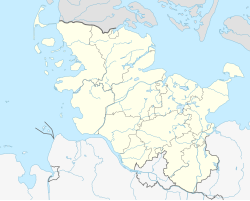Lübeck
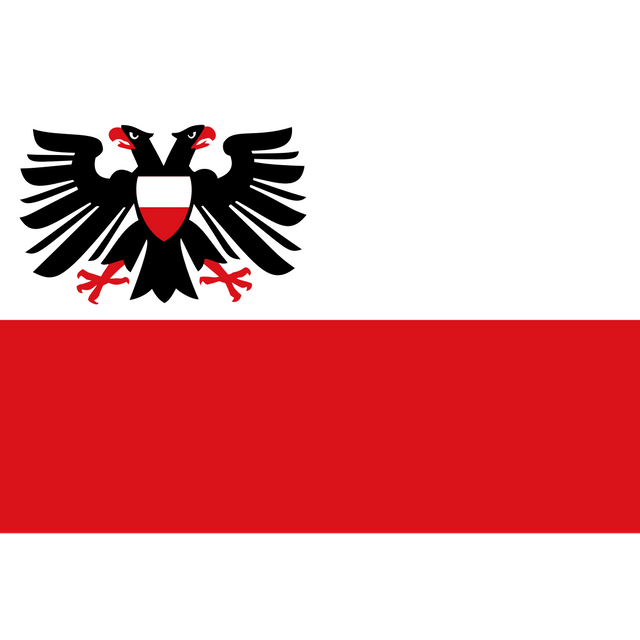
Lübeck

Lübeck | |
|---|---|
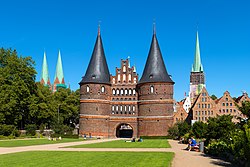 Holstentor, emblem of the city | |
Location of Lübeck | |
| Coordinates:53°52′11″N 10°41′11″E [19] | |
| Country | Germany |
| State | Schleswig-Holstein |
| District | Urban districts of Germany |
| Subdivisions | 35 Stadtbezirke |
| Government | |
| • Mayor | Jan Lindenau (SPD) |
| • Governing parties | CDU |
| Area | |
| • Total | 214.13 km2(82.68 sq mi) |
| Elevation | 13 m (43 ft) |
| Population (2018-12-31)[1] | |
| • Total | 217,198 |
| • Density | 1,000/km2(2,600/sq mi) |
| Time zone | CET/CEST (UTC+1/+2) |
| Postal codes | 23501−23570 |
| Dialling codes | 0451, 04502 |
| Vehicle registration | HL (1906–1937; since 1956)[2] |
| Website | www.luebeck.de [20] |
| UNESCO World Heritage Site | |
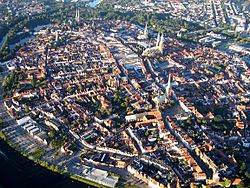 Aerial view of the old town | |
| Criteria | Cultural: iv |
| Reference | 272 [21] |
| Inscription | 1987 (11th Session) |
| Area | 81.1 ha |
| Buffer zone | 693.8 ha |
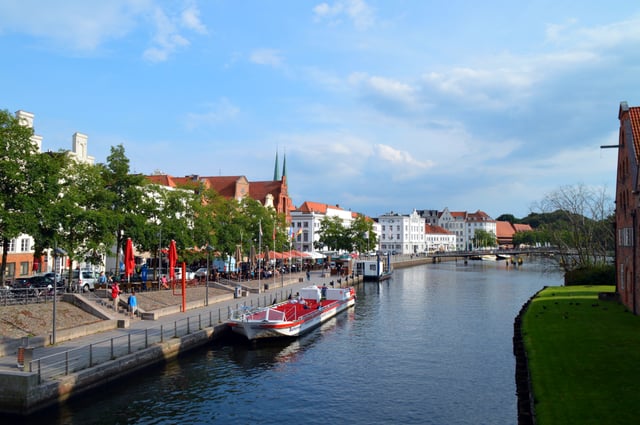
River Trave
Lübeck (/ˈluːbɛk/ LOO-bek, German: [ˈlyːbɛk] (listen)), officially the Hanseatic City of Lübeck (German: Hansestadt Lübeck), is a city in Schleswig-Holstein, northern Germany, and one of the major ports of Germany. On the river Trave, it was the leading city of the Hanseatic League, and because of its extensive Brick Gothic architecture, it is listed by UNESCO as a World Heritage Site. In 2015, it had a population of 218,523.
The old part of Lübeck is on an island enclosed by the Trave. The Elbe–Lübeck Canal connects the Trave with the Elbe River. Another important river near the town centre is the Wakenitz. Autobahn 1 connects Lübeck with Hamburg and Denmark. Travemünde is a sea resort and ferry port on the coast of the Baltic Sea. Lübeck Hauptbahnhof links Lübeck to a number of railway lines, notably the line to Hamburg.
Lübeck | |
|---|---|
 Holstentor, emblem of the city | |
Location of Lübeck | |
| Coordinates:53°52′11″N 10°41′11″E [19] | |
| Country | Germany |
| State | Schleswig-Holstein |
| District | Urban districts of Germany |
| Subdivisions | 35 Stadtbezirke |
| Government | |
| • Mayor | Jan Lindenau (SPD) |
| • Governing parties | CDU |
| Area | |
| • Total | 214.13 km2(82.68 sq mi) |
| Elevation | 13 m (43 ft) |
| Population (2018-12-31)[1] | |
| • Total | 217,198 |
| • Density | 1,000/km2(2,600/sq mi) |
| Time zone | CET/CEST (UTC+1/+2) |
| Postal codes | 23501−23570 |
| Dialling codes | 0451, 04502 |
| Vehicle registration | HL (1906–1937; since 1956)[2] |
| Website | www.luebeck.de [20] |
| UNESCO World Heritage Site | |
 Aerial view of the old town | |
| Criteria | Cultural: iv |
| Reference | 272 [21] |
| Inscription | 1987 (11th Session) |
| Area | 81.1 ha |
| Buffer zone | 693.8 ha |
History
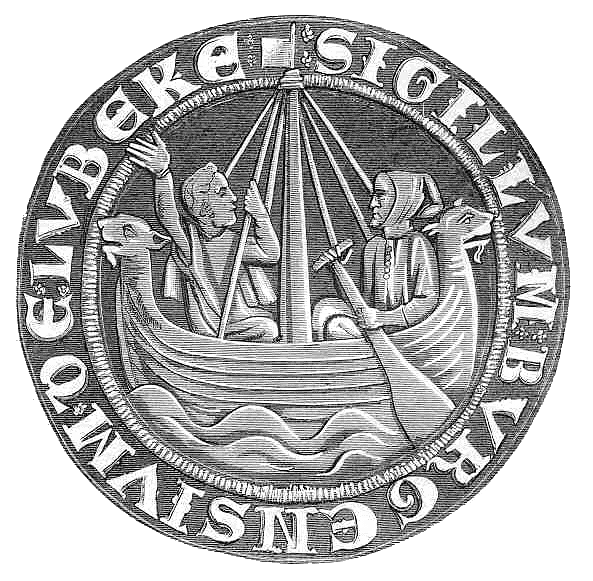
Lübeck's seal, 1280
Humans settled in the area around what today is Lübeck after the last Ice Age ended about 9700 BCE. Several Neolithic dolmens can be found in the area.
Around AD 700, Slavic peoples started moving into the eastern parts of Holstein, an area previously settled by Germanic inhabitants who had moved on in the Migration Period. Charlemagne (Holy Roman Emperor 800–814), whose efforts to Christianise the area were opposed by the Germanic Saxons, expelled many of the Saxons and brought in Polabian Slavs allies. Liubice (the place-name means "lovely") was founded on the banks of the River Trave about 4 km (2.5 mi) north of the present-day city-center of Lübeck. In the 10th century, it became the most important settlement of the Obotrite confederacy and a castle was built. In 1128, the pagan Rani from Rügen razed Liubice.
In 1143, Adolf II, Count of Schauenburg and Holstein, founded the modern town as a German settlement on the river island of Bucu. He built a new castle, first mentioned by the chronicler Helmold as existing in 1147. Adolf had to cede the castle to the Duke of Saxony, Henry the Lion, in 1158. After Henry's fall from power in 1181, the town became an Imperial city for eight years. Emperor Barbarossa (reigned 1152–1190) ordained that the city should have a ruling council of 20 members. With the council dominated by merchants, pragmatic trade interests shaped Lübeck's politics for centuries. The council survived into the 19th century. The town and castle changed ownership for a period afterwards and formed part of the Duchy of Saxony until 1192, of the County of Holstein until 1217, and of the kingdom of Denmark until the Battle of Bornhöved in 1227.
Hanseatic city
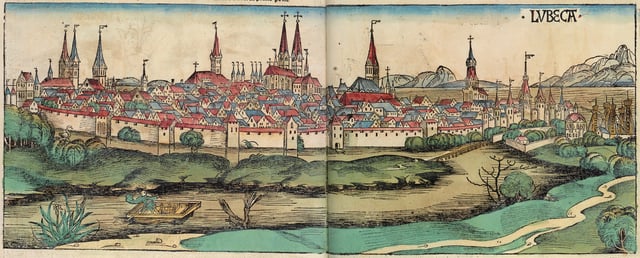
Lübeck in 1493
Around 1200, the port became the main point of departure for colonists leaving for the Baltic territories conquered by the Livonian Order, and later, by the Teutonic Order. In 1226, Emperor Frederick II elevated the town to the status of an Imperial free city, by which it became the Free City of Lübeck.
| Goods | Principal origin | Imports | Exports | Total |
|---|---|---|---|---|
| Cloth | Flanders | 120.8 | 39.7 | 160.5 |
| Fish | Scania | 64.7 | 6.1 | 70.8 |
| Salt | Luneburg | 61.6 | 61.6 | |
| Butter | Sweden | 19.2 | 6.8 | 26 |
| Skins, furs | Russia, Sweden | 13.3 | 3.7 | 17 |
| Grain | Prussia | 13 | 0.8 | 13.8 |
| Wax | Russia, Prussia | 7.2 | 5.8 | 13 |
| Beer | Wendish towns | 4.1 | 1.9 | 6 |
| Copper | Sweden, Hungary | 2.2 | 2.4 | 4.6 |
| Iron | Sweden, Hungary | 2.4 | 2.2 | 4.6 |
| Oil | Flanders | 2.7 | 1.5 | 4.2 |
| Flax | Livonia, North Germany | 0.4 | 3 | 3.4 |
| Foodstuffs | passim | 2.2 | 1.2 | 3.4 |
| Silver | Sweden | 0.7 | 2 | 2.7 |
| Wine | Rhineland | 1.3 | 0.9 | 2.2 |
| Various | 39.9 | 16.6 | 56.5 | |
| Unclassified | 41 | 49 | 90 | |
| Total (rounded) | 338.9 | 206.9 | 545.8[3] |
In the 14th century, Lübeck became the "Queen of the Hanseatic League", being by far the largest and most powerful member of that medieval trade organization. In 1375, Emperor Charles IV named Lübeck one of the five "Glories of the Empire", a title shared with Venice, Rome, Pisa, and Florence.
| Arrivals | % | Origin, destination | Departures | % |
|---|---|---|---|---|
| 289 | 33.7 | Mecklenburg-Pomerania | 386 | 42.3 |
| 250 | 28.8 | Skania | 207 | 22.8 |
| 145 | 16.8 | Prussia | 183 | 20.1 |
| 96 | 11.2 | Sweden | 64 | 7 |
| 35 | 4.3 | Livonia | 43 | 4.7 |
| 28 | 3.2 | Fehmarn | 27 | 3 |
| 12 | 1.6 | Bergen | ||
| 3 | 0.4 | Flanders | 1 | 0.1 |
| 858 | 100 | 911 | 100[4] |
Several conflicts about trading privileges resulted in fighting between Lübeck (with the Hanseatic League) and Denmark and Norway – with varying outcome. While Lübeck and the Hanseatic League prevailed in conflicts in 1435 and 1512, Lübeck lost when it became involved in the Count's Feud, a civil war that raged in Denmark from 1534 to 1536. Lübeck also joined the pro-Lutheran Schmalkaldic League of the mid-16th century.
| Butter | Copper | |||||||
|---|---|---|---|---|---|---|---|---|
| Year | Lübeck | % | Danzig | % | Lübeck | % | Danzig | % |
| 1368 | 2000 | 460 | ||||||
| 1369 | 900 | 530 | ||||||
| 1400 | 247 | 45 | ||||||
| 1492 | 76 | 1250 | ||||||
| 1493 | 2849 | |||||||
| 1494 | 1906 | |||||||
| 1495 | 435 | |||||||
| 1559 | 1254 | 89 | 150 | 11 | ||||
| 1572 | 1350 | 74 | 252 | 14 | 564 | 94 | 3 | 0.5 |
| 1582 | 1224 | 86 | 105 | 10 | 803 | 85 | 59 | 6.2 |
| 1583 | 1133 | 77 | 165 | 11 | 2153 | 70 | 122 | 4 |
| 1584 | 909 | 74 | 177 | 14 | 2415 | 69 | 49 | 1.4 |
| 1591 | 742 | 74 | 170 | 17 | 1487 | 74 | 247 | 12 |
| 1600 | 56 | 5 | 1 | 0 | ||||
| 1610 | 64 | 47 | 7 | 5 | 1411 | 83 | 18 | 1.1 |
| 1620 | 659 | 76 | 50 | 6 | 7434 | 86 | 12 | 0.1[6] |
After its defeat in the Count's Feud, Lübeck's power slowly declined. The city remained neutral in the Thirty Years' War of 1618–1648, but the combination of the devastation from the decades-long war and the new transatlantic orientation of European trade caused the Hanseatic League – and thus Lübeck with it – to decline in importance. However, even after the de facto disbanding of the Hanseatic League in 1669, Lübeck still remained an important trading town on the Baltic Sea.
Old traditions, new challenges
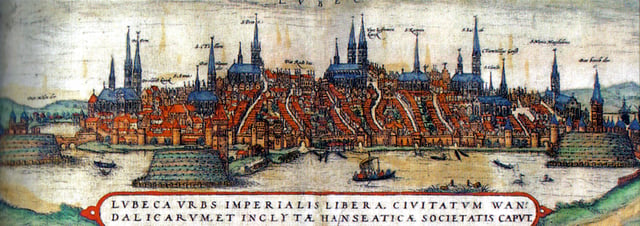
Lübeck, 16th century

Lübeck in 1641
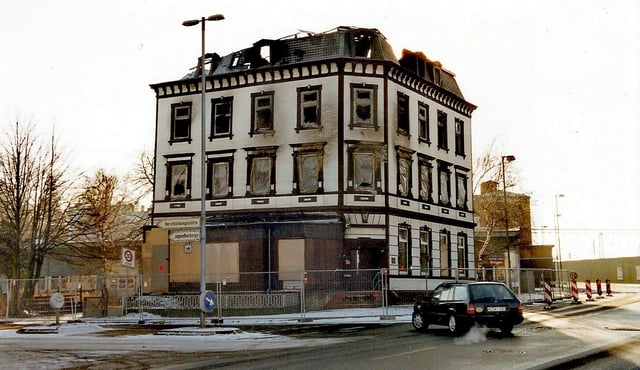
The house after the fire
Franz Tunder was the organist in the Marienkirche. It was part of the tradition in this Lutheran congregation that the organist would pass on the duty in a dynastic marriage. In 1668, his daughter Anna Margarethe married the great Danish-German composer Dieterich Buxtehude, who was the organist at the Marienkirche in Lübeck until at least 1703. Some of the greatest composers of the day came to the church to hear his renowned playing.
In the course of the war of the Fourth Coalition against Napoleon, troops under Bernadotte (who would later become King of Sweden) occupied the neutral Lübeck after a battle against Blücher on 6 November 1806. Under the Continental System, the State bank went into bankruptcy. In 1811, the French Empire formally annexed Lübeck as part of France; the anti-Napoleonic allies liberated the area in 1813, and the Congress of Vienna of 1815 recognised Lübeck as an independent free city.
Writer Thomas Mann was a member of the Mann family of Lübeck merchants. His well-known 1901 novel Buddenbrooks made readers in Germany (and later worldwide, through numerous translations) familiar with the manner of life and mores of the 19th-century Lübeck bourgeoisie.
In 1937, the Nazis passed the so-called Greater Hamburg Act, which merged the city of Lübeck with Prussia.
During World War II (1939–1945), Lübeck became the first German city to suffer substantial Royal Air Force (RAF) bombing. The attack of 28 March 1942 created a firestorm that caused severe damage to the historic centre. This raid destroyed three of the main churches and large parts of the built-up area; the bells of St Marienkircke plunged to the stone floor.[7] Germany operated a prisoner-of-war camp for officers, Oflag X-C, near the city from 1940 until April 1945. The British Second Army entered Lübeck on 2 May 1945 and occupied it without resistance.
On 3 May 1945, one of the biggest disasters in naval history occurred in the Bay of Lübeck when RAF bombers sank three ships: the SS Cap Arcona, the SS Deutschland, and the SS Thielbek – which, unknown to them, were packed with concentration-camp inmates. About 7,000 people died.
Lübeck's population grew considerably, from about 150,000 in 1939 to more than 220,000 after the war, owing to an influx of ethnic German refugees expelled from the so-called former eastern provinces of Germany in the Communist Bloc. Lübeck remained part of Schleswig-Holstein after World War II (and consequently lay within West Germany). It stood directly on what became the inner German border during the division of Germany into two states in the Cold War period. South of the city, the border followed the path of the river Wakenitz, which separated the Germanys by less than 10 m (32.81 ft) in many parts. The northernmost border crossing was in Lübeck's district of Schlutup. Lübeck spent decades restoring its historic city centre. In 1987, UNESCO designated this area a World Heritage Site.
Lübeck became the scene of a notable art scandal in the 1950s. Lothar Malskat was hired to restore the medieval frescoes of the cathedral of the Marienkirche, which were discovered after the cathedral had been badly damaged during World War II. Instead, he painted new works, which he passed off as restorations, fooling many experts. Malskat later revealed the deception himself. Günter Grass featured this incident in his 1986 novel The Rat.
On the night of 18 January 1996, a fire broke out in a home for foreign refugees, killing 10 people and severely injuring more than 30 others, mostly children. Most of the shelter's inhabitants thought it was a racist attack, as they stated that they had encountered other overt hostility in the city.[8] The police and the local court were criticized at the time for ruling out racism as a possible motive before even beginning preliminary investigations.[9] But by 2002, the courts found all the Germans involved[10] not guilty; the perpetrators have not been caught.[11] -->
In April 2015, Lübeck hosted the G7 conference. [12]
Demographics
In 2015, the city had a population of 218,523. The largest ethnic minority groups are Turks, Central Europeans (Poles), Southern Europeans (mostly Greeks and Italians), Eastern Europeans (e.g. Russians), Arabs, and several smaller groups.
Population development since 1227:
| Historical population | ||
|---|---|---|
| Year | Pop. | ±% |
| 1227 | 6,000 | — |
| 1400 | 17,200 | +186.7% |
| 1600 | 22,570 | +31.2% |
| 1708 | 19,978 | −11.5% |
| 1871 | 39,743 | +98.9% |
| 1900 | 82,098 | +106.6% |
| 1910 | 98,656 | +20.2% |
| 1925 | 120,788 | +22.4% |
| 1939 | 154,811 | +28.2% |
| 1950 | 238,276 | +53.9% |
| 1961 | 235,200 | −1.3% |
| 1970 | 239,339 | +1.8% |
| 1987 | 210,497 | −12.1% |
| 2011 | 210,305 | −0.1% |
| 2017 | 216,318 | +2.9% |
| source:[13] | ||
Population structure: [14]
Main sights
Buildings
Much of the old town has kept a medieval appearance with old buildings and narrow streets. At one time, the town could only be entered by any of four town gates, two of which remain today, the well-known Holstentor (1478) and the Burgtor (1444).
The old town centre is dominated by seven church steeples. The oldest are the Lübecker Dom (the city's cathedral) and the Marienkirche (Saint Mary's), both from the 13th and 14th centuries.
Built in 1286, the Holy Spirit Hospital at Koberg is one of the oldest existing social institutions in the world and one of the most important buildings in the city. The Holy Spirit Hospital is in parts an old-folk and nursing home. Historic parts can be visited.
Other sights include:
the Lübecker Rathaus (Town Hall)
St. Catherine's Church, a church that belonged to a former monastery, now the Katharineum, a Latin school
Thomas Mann's house
Günter Grass' house
Church of St Peter Petrikirche (Lübeck)
Church of St Lawrence, located on the site of a cemetery for people who died during the 16th-century plague
Church of St Jacob Lübecker Jakobikirche, 1334
Church of the Sacred Heart (Propsteikirche Herz Jesu)
Church of St Aegidien
the Salzspeicher, historic warehouses where salt delivered from Lüneburg awaited shipment to Baltic ports
Like many other places in Germany, Lübeck has a long tradition of a Christmas market in December, which includes the famous handicrafts market inside the Heiligen-Geist-Hospital (Hospital of the Holy Spirit), located at the northern end of Königstrasse.
Museums
Lübeck has many small museums, such as the St. Anne's Museum Quarter, Lübeck, the Behnhaus, the European Hansemuseum, and the Holstentor. Lübeck Museum of Theatre Puppets is a privately run museum. Waterside attractions are a lightvessel that served Fehmarnbelt and the Lisa von Lübeck, a reconstruction of a Hanseatic 15th century caravel. The marzipan museum in the second floor of Café Niederegger in Breite Strasse explains the history of marzipan, and shows historical wood molds for the production of marzipan blocks and a group of historical figures made of marzipan.
Food and drink
Lübeck is famous for its marzipan industry. According to local legend, marzipan was first made in Lübeck, possibly in response either to a military siege of the city or a famine year. The story, perhaps apocryphal, is that the town ran out of all food except stored almonds and sugar, which were used to make loaves of marzipan "bread". [15] Others believe that marzipan was actually invented in Persia a few hundred years before Lübeck claims to have invented it. The best known producer is Niederegger, which tourists often visit while in Lübeck, especially at Christmas time. [16]
Education
Lübeck has three universities, the University of Lübeck, the Technical University of Applied Sciences Lübeck, and the Lübeck Academy of Music. The Graduate School for Computing in Medicine and Life Sciences [22] is a central faculty of the University and was founded by the German Excellence Initiative [23] . The International School of New Media is an affiliated institute of the university.
Notable people

C.F.Heineken 1726

Ephraim Carlebach 1936
Laurentius Surius (1522-1578), Carthusian monk [18] and hagiograph
August Hermann Francke (1663-1727), pedagogue, [19] theologian, founded the Francke Foundations
Adam Brand, (before 1692-1746), German merchant and researcher
Johann Lorenz von Mosheim (1693–1755) German Lutheran [20] church historian
Christian Friedrich Heinecken (1721-1725), "the infant scholar of Lübeck", a child prodigy [21]
Kurd von Schlözer (1822-1894), diplomat and historian
John Rugee (1827-1894), politician in Wisconsin, USA
Hermann von der Hude (1830-1908), architect
Ephraim Carlebach (1879-1936), rabbi and founder of the Higher Israelite School in Leipzig
Friedrich Ranke (1882-1950), Germanist and ethnologist
Joseph Carlebach (1883-1942), rabbi, victim of the Holocaust
Hermann Pister (1885-1948), Nazi SS commandant of Buchenwald Concentration Camp
Walter Ewers (1892-1918), flying ace of WWI
Felix Carlebach (1911-2008), rabbi
Hans Blumenberg (1920-1996), philosopher
Jörg Ziercke (born 1947) chief commissioner of the Federal Criminal Police Office 2004/2014
Sandra Völker (born 1974), swimmer
Politics
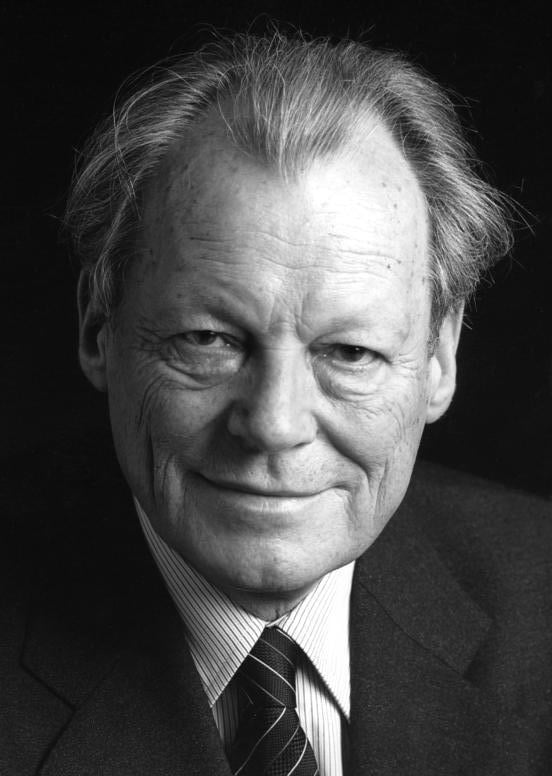
Willy Brandt in 1980
Johann Wittenborg (1321– (beheaded 1363) Mayor of Lübeck, lost the Battle of Helsingborg (1362)
Jürgen Wullenwever (c.1492–1537) was burgomaster of Lübeck from 1533 to 1535
Friedrich Krüger (1819-1896) diplomat, served the Hanseatic cities of Lübeck, Hamburg and Bremen
Gustav Radbruch (1878-1949), legal scholar and politician
Hermann Lüdemann (1880-1959), politician (CDU)
Otto-Heinrich Drechsler (1895–1945) Mayor of Lübeck 1933 to 1937, set up the Riga ghetto
Haim Cohn (1911-2002) an Israeli jurist and politician.
Willy Brandt (1913-1992), politician, [22] German chancellor (SPD)
Björn Engholm (born 1939), politician (SPD)
Robert Habeck (born 1969) writer and politician of the Alliance '90/The Greens
Beatrix von Storch (born 1971) Alternative for Germany politician, former MEP
George Wulweber, 16th-century Protestant who was tortured on the rack
Art

JF Overbeck, self portrait with family 1820

Dieterich Buxtehude
Benjamin Block (1631–1690) German-Hungarian Baroque [23] painter
Sir Godfrey Kneller (1646-1723), court painter [24] of several British monarchs
Catharina Elisabeth Heinecken (1683–1757), German artist and alchemist
Carl Heinrich von Heineken (1707–1791), German art historian
Friedrich Overbeck (1789-1869), painter [25] and head of the Nazarenes
Johann Wilhelm Cordes (1824-1869) landscape painter.
Gotthardt Kuehl (1850-1915), painter
Maria Slavona (1865-1931), impressionist painter, sister of Cornelia Schorer
Erich Ponto (1884-1957), actor
Walter D. Asmus (born 1941) theatre director [26]
Justus von Dohnányi (born 1960), actor
Jonas Nay (born 1990), actor
Music
Franz Tunder (1614-1667), organist and composer
Thomas Baltzar (around 1631-1663), violinist [27] and composer
Dieterich Buxtehude, (c.1637-1707), composer and organist
Andreas Kneller (1649-1724), composer and organist
Friedrich Ludwig Æmilius Kunzen (1761-1817), composer
Science
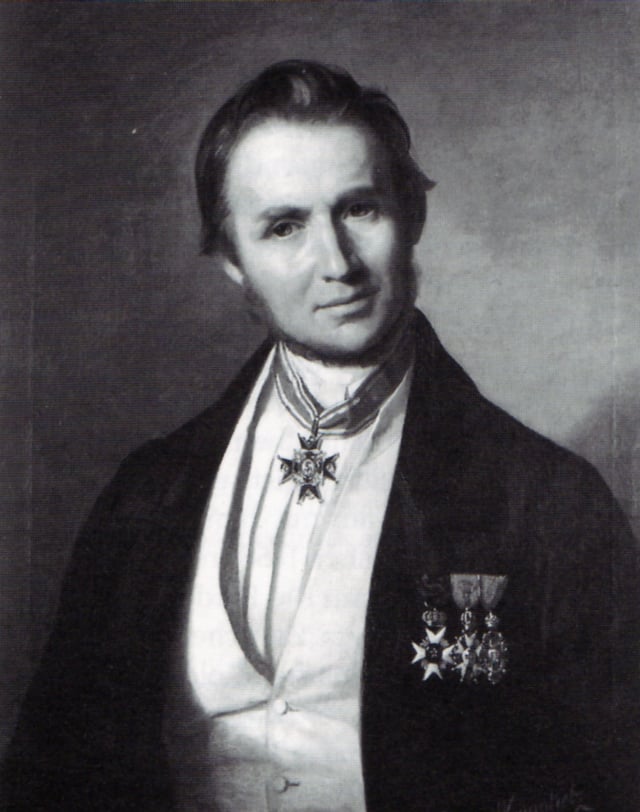
Robert Christian Ave-Lallemant in 1851
Joachim Jungius (1587-1657), mathematician, physicist, and philosopher
Heinrich Meibom (1638-1700), medical expert, discovered the Meibomian gland
Hermann von Fehling (1811-1885) chemist [28]
Robert Christian Avé-Lallemant (1812-1884), physician and research traveler
Ernst Curtius, (1814-1896), classical archaeologist [29] and historian
Georg Curtius (1820–1885) philologist [30]
Friedrich Matthias Claudius (1822-1869), anatomist
James Behrens (1824-1898), entomologist [31]
Friedrich Matz (1843-1874), archaeologist
Friedrich Wilhelm Gustav Bruhn (1853-1927) invented the taximeter
Heinrich Lüders (1869-1943) Orientalist and Indologist
Justus Mühlenpfordt (1911–2000) nuclear physicist
Writing

Heinrich (left) and Thomas Mann in 1902
Erasmus Finx (1627-1694), polyhistorian, author and church writer
Christian Adolph Overbeck (1755-1821), mayor and poet
Johann Bernhard Vermehren (1777-1803), romanticist and lecturer
Emanuel Geibel (1815-1884), poet [32]
Gustav Falke (1853-1916), author
Heinrich Mann (1871-1950), novelist (Professor Unrat)
Thomas Mann (1875-1955), novelist, Nobel Prize for Literature in 1929
Jörg Wontorra (born 1948), German sport journalist
Parts

The skyline of the old town as seen from North

Lübeck main station (Lübeck Hbf)

Lübeck civil registration office, in the St. Jürgen zone

The beach of Travemünde
The city of Lübeck is divided into 10 zones. These again are arranged into altogether 35 urban districts. The 10 zones with their official numbers, their associated urban districts and the numbers of inhabitants of the quarters:
01 City centre (~ 12,000 Inhabitants)
The Innenstadt is the main tourist attraction and consists of the old town as well as the former ramparts. It is the oldest and smallest part of Lübeck.
02 St. Jürgen (~ 40,000 Inhabitants) Hüxtertor / Mühlentor / Gärtnergasse, Strecknitz / Rothebek, Blankensee, Wulfsdorf, Beidendorf, Krummesse, Kronsforde, Niederbüssau, Vorrade, Schiereichenkoppel, Oberbüssau
Sankt Jürgen is one of three historic suburbs of Lübeck (alongside St. Lorenz and St. Gertrud). It is located South of the city centre and the biggest of all city parts.
03 Moisling (~ 10,000 Inhabitants) Niendorf / Moorgarten, Reecke, Old-Moisling / Genin
Moisling is situated in the far South-West. Its history dates back to the 17th century.
04 Buntekuh (~ 10,000 Inhabitants)
Buntekuh lies in the West of Lübeck. A big part consists of commercial zones such as the Citti-Park, Lübeck's biggest mall.
05 St. Lorenz-South (~ 12,000 Inhabitants)
Sankt Lorenz-Süd is located right in the South-West of the city centre and has the highest population density. The main train and bus station lie in its Northern part.
06 St. Lorenz-North (~ 40,000 Inhabitants) Holstentor-North, Falkenfeld / Vorwerk / Teerhof, Großsteinrade / Schönböcken, Dornbreite / Krempelsdorf
Sankt Lorenz-Nord is situated in the North-West of Lübeck. It is split from its southern part by the railways.
07 St. Gertrud (~ 40,000 Inhabitants) Burgtor / Stadtpark, Marli / Brandenbaum, Eichholz, Karlshof / Israelsdorf / Gothmund
Sankt Gertrud is located in the East of the city centre. This part is mainly characterized by its nature. Many parks, the rivers Wakenitz and Trave and the forest Lauerholz make up a big part of its area.
08 Schlutup (~ 6,000 Inhabitants)
Schlutup lies in the far East of Lübeck. Due to forest Lauerholz in its West and river Trave in the North, Schlutup is relatively isolated from the other city parts.
09 Kücknitz (~ 20,000 Inhabitants) Dänischburg / Siems / Rangenberg / Wallberg, Herrenwyk, Alt-Kücknitz / Dummersdorf / Roter Hahn, Poeppendorf
North of river Trave lies Kücknitz. It is the old main industrial area of Lübeck.
10 Travemünde (~ 15,000 Inhabitants) Ivendorf, Alt-Travemünde / Rönnau, Priwall, Teutendorf, Brodten
Travemünde is located in the far North-East of Lübeck at the Baltic Sea. With its long beach and coast line, Travemünde is the second biggest tourist destination.
International relations
Lübeck is twinned with:
|
Lubec, Maine, the easternmost town in the United States, is named after Lübeck.
See also
Cap Arcona
Lübeck Airport
Lübeck Hauptbahnhof
Lübeck Nordic Film Days
Lübecker Nachrichten is Lübeck's only newspaper
Oberschule zum Dom
Ports of the Baltic Sea
Schleswig-Holstein Musik Festival
VfB Lübeck, football and sports club
Bombing of Lübeck in World War II




